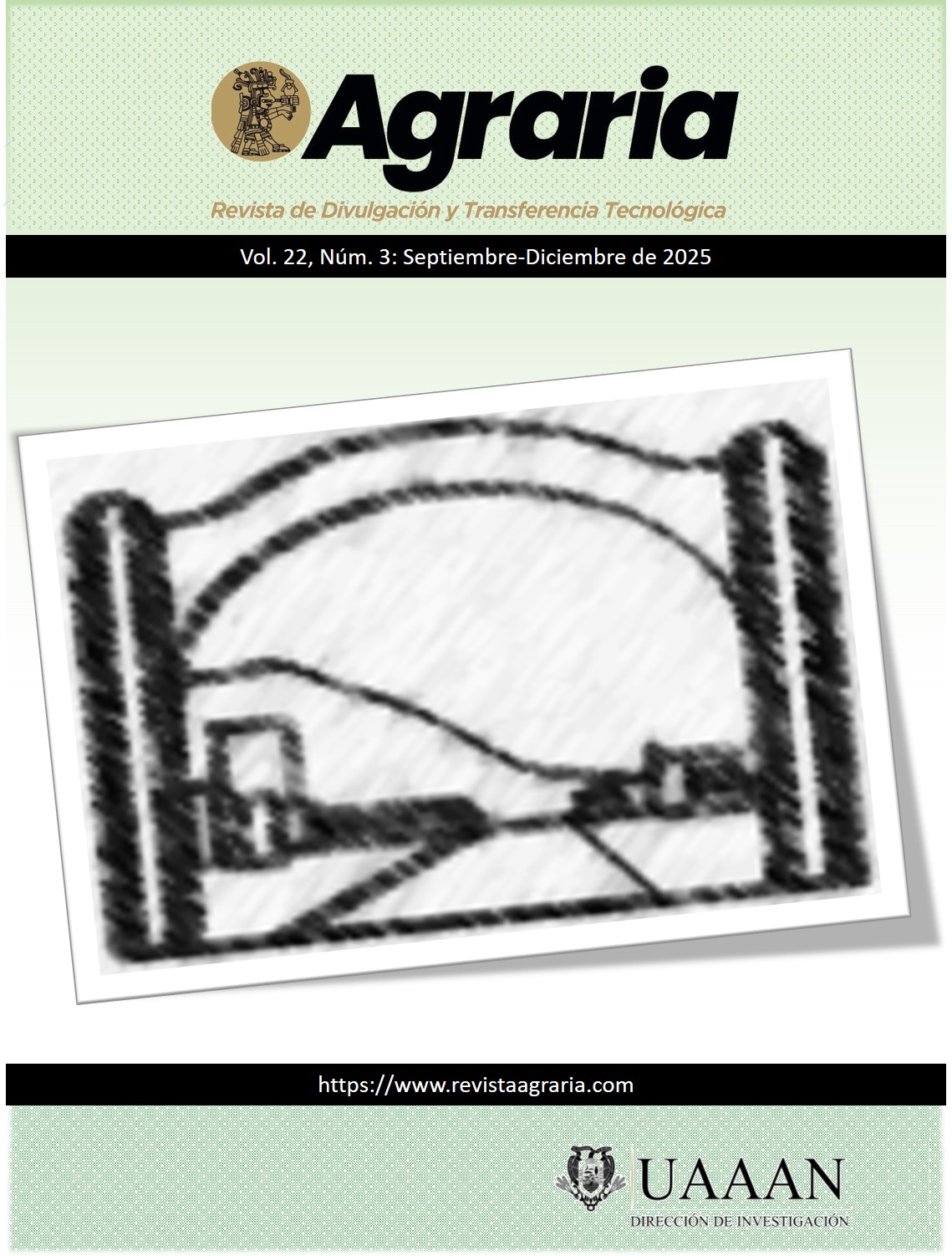Probióticos y gelación iónica: una alternativa para el bienestar intestinal en humanos
DOI:
https://doi.org/10.59741/agraria.v22i3.636Palabras clave:
Probióticos, Encapsulación, Gelación iónicaResumen
La encapsulación de probióticos, especialmente mediante gelación iónica, es clave para optimizar su efectividad y asegurar que lleguen al intestino delgado y colon, donde pueden mejorar la salud intestinal. Esta técnica protege a los probióticos de las condiciones adversas del sistema digestivo y facilita su liberación controlada en el intestino, maximizando su beneficio. Además, la gelación iónica es sencilla, económica y segura, lo cual permite su uso en la producción de alimentos y suplementos probióticos. Así, se potencia el impacto positivo de los probióticos, mejorando el equilibrio de la microbiota y contribuyendo a una mejor digestión.
Descargas
Referencias
Adilah, R. N., Chiu, S., Hu, S., Ballantyne, R., Happy, N., Cheng, A., & Liu, C. (2022). Improvement in the probiotic efficacy of Bacillus subtilis E20-stimulates growth and health status of white shrimp, Litopenaeus vannamei via encapsulation in alginate and coated with chitosan. Fish & Shellfish Immunology, 125, 74-83. https://doi.org/10.1016/j.fsi.2022.05.002 DOI: https://doi.org/10.1016/j.fsi.2022.05.002
Alkhatib, H., Doolaanea, A. A., Assadpour, E., Sabere, A. S. M., Mohamed, F., & Jafari, S. M. (2022). Optimizing the encapsulation of black seed oil into alginate beads by ionic gelation. Journal Of Food Engineering, 328, 111065. https://doi.org/10.1016/j.jfoodeng.2022.111065 DOI: https://doi.org/10.1016/j.jfoodeng.2022.111065
Guo, Q., Li, S., Tang, J., Chang, S., Qiang, L., Du, G., Yue, T., & Yuan, Y. (2022). Microencapsulation of Lactobacillus plantarum by spray drying: Protective effects during simulated food processing, gastrointestinal conditions, and in kefir. International Journal of Biological Macromolecules, 194, 539-545. https://doi.org/10.1016/j.ijbiomac.2021.11.096 DOI: https://doi.org/10.1016/j.ijbiomac.2021.11.096
Holkem, A. T., Raddatz, G. C., Barin, J. S., Flores, É. M. M., Muller, E. I., Codevilla, C. F., Jacob-Lopes, E., Grosso, C. R. F., & De Menezes, C. R. (2016). Production of microcapsules containing Bifidobacterium BB-12 by emulsification/internal gelation. LWT, 76, 216-221. https://doi.org/10.1016/j.lwt.2016.07.013 DOI: https://doi.org/10.1016/j.lwt.2016.07.013
Lasta, E. L., da Silva Pereira Ronning, E., Dekker, R. F. H., & da Cunha, M. A. A. (2021). Encapsulation and dispersion of Lactobacillus acidophilus in a chocolate coating as a strategy for maintaining cell viability in cereal bars. Scientific Reports, 11(1), 1–12. https://doi.org/10.1038/s41598-021-00077-0 DOI: https://doi.org/10.1038/s41598-021-00077-0
Latif, A., Shehzad, A., Niazi, S., Zahid, A., Ashraf, W., Iqbal, M. W., Rehman, A., Riaz, T., Aadil, R. M., Khan, I. M., Özogul, F., Rocha, J. M., Esatbeyoglu, T., & Korma, S. A. (2023). Probiotics: mechanism of action, health benefits and their application in food industries. Frontiers In Microbiology, 14. https://doi.org/10.3389/fmicb.2023.1216674 DOI: https://doi.org/10.3389/fmicb.2023.1216674
Liao, Y., Hu, Y., Fu, N., Hu, J., Xiong, H., Chen, X. D., & Zhao, Q. (2021). Maillard conjugates of whey protein isolate-xylooligosaccharides for the microencapsulation of: Lactobacillus rhamnosus: Protective effects and stability during spray drying, storage and gastrointestinal digestion. Food and Function, 12(9), 4034–4045. https://doi.org/10.1039/d0fo03439h DOI: https://doi.org/10.1039/D0FO03439H
Mazziotta, C., Tognon, M., Martini, F., Torreggiani, E., & Rotondo, J. C. (2023). Probiotics Mechanism of Action on Immune Cells and Beneficial Effects on Human Health. Cells, 12(1), 184. https://doi.org/10.3390/cells12010184 DOI: https://doi.org/10.3390/cells12010184
Mingkang, L., Chen, J., Dharmasiddhi, I. P. W., Chen, S., Liu, Y., & Liu, H. (2024). Review of the Potential of Probiotics in Disease Treatment: Mechanisms, Engineering, and Applications. Processes, 12(2), 316. https://doi.org/10.3390/pr12020316 DOI: https://doi.org/10.3390/pr12020316
Miranda-Linares, V., Quintanar-Guerrero, D., Del Real, A., & Zambrano-Zaragoza, M. (2019). Spray-drying method for the encapsulation of a functionalized ingredient in alginate-pectin nano- and microparticles loaded with distinct natural actives: Stability and antioxidant effect. Food Hydrocolloids, 101, 105560. https://doi.org/10.1016/j.foodhyd.2019.105560 DOI: https://doi.org/10.1016/j.foodhyd.2019.105560
Obradović, N., Volić, M., Nedović, V., Rakin, M., & Bugarski, B. (2022). Microencapsulation of probiotic starter culture in protein–carbohydrate carriers using spray and freeze-drying processes: Implementation in whey-based beverages. Journal Of Food Engineering, 321, 110948. https://doi.org/10.1016/j.jfoodeng.2022.110948 DOI: https://doi.org/10.1016/j.jfoodeng.2022.110948
Ortiz-Romero, N., Ochoa-Martínez, L. A., González-Herrera, S. M., Rutiaga-Quiñones, O. M., & Gallegos-Infante, J. A. (2021). Avances en las investigaciones sobre la encapsulación mediante gelación iónica: una revisión sistemática. TecnoLógicas, 24(52), e1962. https://doi.org/10.22430/22565337.1962 DOI: https://doi.org/10.22430/22565337.1962
Romero-Chapol, O. O., Varela-Pérez, A., Castillo-Olmos, A. G., García, H. S., Singh, J., García-Ramírez, P. J., Viveros-Contreras, R., Figueroa-Hernández, C. Y., & Cano-Sarmiento, C. (2022). Encapsulation of Lacticaseibacillus rhamnosus GG: Probiotic Survival, In Vitro Digestion and Viability in Apple Juice and Yogurt. Applied Sciences (Switzerland), 12(4). https://doi.org/10.3390/app12042141 DOI: https://doi.org/10.3390/app12042141
Spacova, I., Van Beeck, W., Seys, S., Devos, F., Vanoirbeek, J., Vanderleyden, J., Ceuppens, J., Petrova, M., & Lebeer, S. (2020). Lactobacillus rhamnosus probiotic prevents airway function deterioration and promotes gut microbiome resilience in a murine asthma model. Gut Microbes, 11(6), 1729-1744. ttps://doi.org/10.1080/19490976.2020.1766345 DOI: https://doi.org/10.1080/19490976.2020.1766345
Vigil-Cuate, L. K., Avila-Reyes, S. V., Camacho-Díaz, B. H., Hernández-Sánchez, H., Osorio-Díaz, P., Jiménez-Aparicio, A. R., Robert, P., & Arenas-Ocampo, M. L. (2024). Effect of Agavins and Agave Syrup Use in the Formulation of a Synbiotic Gelatin Gummy with Microcapsules of Saccharomyces Boulardii. Gels, 10(5), 1–17. https://doi.org/10.3390/gels10050299 DOI: https://doi.org/10.3390/gels10050299
West, N. P., Hughes, L., Ramsey, R., Zhang, P., Martoni, C. J., Leyer, G. J., Cripps, A. W., & Cox, A. J. (2021). Probiotics, Anticipation Stress, and the Acute Immune Response to Night Shift. Frontiers In Immunology, 11. https://doi.org/10.3389/fimmu.2020.599547 DOI: https://doi.org/10.3389/fimmu.2020.599547
Descargas
Publicado
Número
Sección
Licencia
Derechos de autor 2025 Universidad Autónoma Agraria Antonio Narro

Esta obra está bajo una licencia internacional Creative Commons Atribución-CompartirIgual 4.0.
Cómo citar
PLUMX Metrics

